Assessing knowledge and beliefs in harm reduction strategies among student pharmacists: A pilot study
IF 1.4
Q3 EDUCATION, SCIENTIFIC DISCIPLINES
引用次数: 0
Abstract
Objective
In 2022 Louisiana ranked 4th in opioid overdose deaths and ranked above the national average in opioid prescription rates. To help combat the opioid epidemic in Louisiana faculty members received a grant for harm reduction education. The purpose of this study is to assess an adaptable education program developed to train student pharmacists on harm reduction and substance use disorders.
Methods
In this IRB approved observational pilot study, student pharmacists were recruited through e-mail to participate in two offerings of an education session. An informed consent was completed at the start of the education session. Pre-survey questions included demographic data, and the pre-survey and post survey included the validated Opioid Overdose Knowledge Scale (OOKS) and Opioid Overdose Attitude Scale (OOAS). A paired two-sided t-test was used to evaluate any changes. The program consisted of an introduction to common opioids, medical facts, stigma, issues with administering opioid reversal medications, Louisiana legislation, fentanyl test strip demonstration, overdose risk factors, and a simulated opioid overdose scenario. At the program's end, each participant received a certificate and a harm reduction kit.
Results
110 participants completed the training with most of the participants identifying as white/Caucasian and female (72 % and 79 % respectively). The OOKS showed a positive 3.83 (p < .001) increase and the OOAS had an increase of 19.90 (p < .001). The competency of managing an overdose subscale showed the largest increase.
Conclusion
Overall participants' opioid overdose knowledge and attitudes increased; therefore, the findings of our study indicate the education program can be used successfully in student pharmacists.
评估知识和信念在减少危害策略学生药剂师:一项试点研究
目的2022年,路易斯安那州阿片类药物过量死亡人数排名第四,阿片类药物处方率高于全国平均水平。为了帮助对抗路易斯安那州的阿片类药物泛滥,教师们获得了一笔减少伤害教育的赠款。本研究的目的是评估一项适应性教育计划,该计划旨在培训学生药剂师减少危害和物质使用障碍。方法:在IRB批准的观察性试点研究中,通过电子邮件招募学生药剂师参加两个教育课程。在教育课程开始时填写知情同意书。调查前问题包括人口统计数据,调查前和调查后包括经验证的阿片类药物过量知识量表(OOKS)和阿片类药物过量态度量表(OOAS)。使用配对双侧t检验来评估任何变化。该计划包括介绍常见的阿片类药物,医学事实,耻辱,管理阿片类药物逆转药物的问题,路易斯安那州立法,芬太尼试纸演示,过量风险因素,以及模拟阿片类药物过量场景。在项目结束时,每位参与者都收到了一份证书和一套减少伤害的工具包。结果110名参与者完成了培训,其中大多数参与者为白人/高加索人和女性(分别为72%和79%)。OOKS为正3.83 (p <;.001)增加,OOAS增加19.90 (p <;措施)。管理服药过量子量表的能力表现出最大的提高。结论总体被试对阿片类药物过量的认知和态度有所提高;因此,本研究的结果表明,该教育方案可以成功地应用于药学专业学生。
本文章由计算机程序翻译,如有差异,请以英文原文为准。
求助全文
约1分钟内获得全文
求助全文
来源期刊

Currents in Pharmacy Teaching and Learning
EDUCATION, SCIENTIFIC DISCIPLINES-
CiteScore
2.10
自引率
16.70%
发文量
192
 求助内容:
求助内容: 应助结果提醒方式:
应助结果提醒方式:


